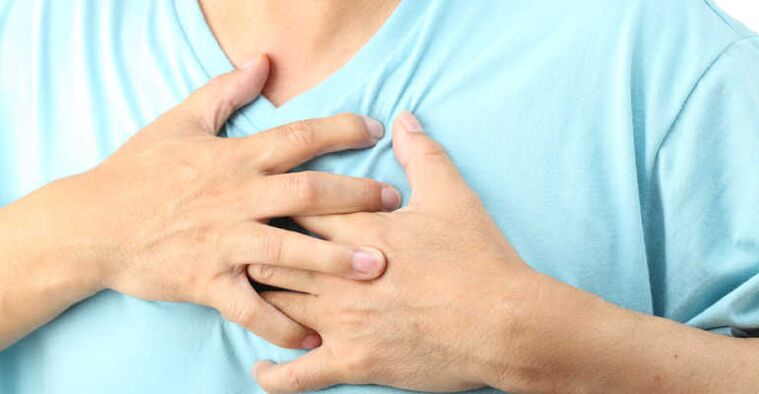
Many people over 45 years of age begin to feel pain in the heart area. This symptom puts the person in a state of panic, because it is unknown what exactly caused this condition.
The idea often comes to mind that serious heart problems have begun and emergency help from cardiologists may be needed. After taking a cardiogram and obtaining a completely satisfactory result, a person's bewilderment only increases.
What could cause pain in the heart? And, most importantly, what to do in such a situation? The answer is really simple, although not everyone knows it. Heart pain often occurs due to other ailments. This situation occurs in particular with thoracic osteochondrosis. Is it worth paying attention to pain of this nature?
How does osteochondrosis appear?
The mechanism is quite simple. Throughout life, a person performs a certain physical activity. Most of it "lies" in the column. To make it easier for the vertebrae to cope with the tasks assigned to them, intervertebral discs are placed between them. The latter, in turn, act as shock absorbers, preventing the vertebrae from rubbing against each other.
Intervertebral discs tend to wear out. The main reason is too intense tension on the spine. Poor nutrition of cartilage tissue can also lead to its gradual destruction.
Microcracks appear on the surface of the cartilage, tissues are destroyed, and as a result of this process, the vertebrae begin to touch each other. As a result of friction, an inflammatory process occurs, which is quite painful.
With thoracic osteochondrosis, active abrasion of the intervertebral discs in the thoracic spine occurs. As a result of the pathology, the patient not only loses resistance, but can no longer perform physical activity in the same volume. He begins to suffer pain, which becomes more and more intense.
To alleviate the patient's condition, specialized treatment is required. If the therapeutic course was not carried out on time, the patient may experience a number of health problems. In particular, various pathologies of the cardiac system may arise.
Main symptoms of osteochondrosis.
There are certain signs that will help identify thoracic osteochondrosis against the background of other diseases.
- First of all, it is worth understanding where exactly the source of the pain is. In thoracic osteochondrosis, the pain comes predominantly from the chest. It can be sharp, as if squeezing it from all sides. There is often a feeling of shortness of breath and even shortness of breath when coughing. Sometimes the pain radiates to the shoulder blade area, where a dull aching sensation appears. Unpleasant pain can "appear" after physical exercise, it also manifests itself after sitting in an uncomfortable position;
- Sometimes thoracic osteochondrosis can appear in the form of numbness in the arms, legs, shoulders and neck. Often limbs freeze even in summer, when there is no reason for it;
- Headaches and dizziness occur periodically.
These are the main signs of thoracic osteochondrosis that you should pay attention to. All of these painful conditions are a result of compression of the blood vessels between the affected vertebrae due to thoracic osteochondrosis. It is believed that in women all of these symptoms are more pronounced.
In addition to these three symptoms, which are considered the main ones, it is also worth paying attention to the back pain that occurs.This is a mild pain syndrome that occurs in the area of damaged vertebrae.
These pains are not intense, sometimes causing a sensation of muscle stiffness. In this case, there is a feeling that the source of the pain is in the stomach, liver or pancreas. In fact, this is a false feeling. Thoracic osteochondrosis has nothing to do with the digestive organs.
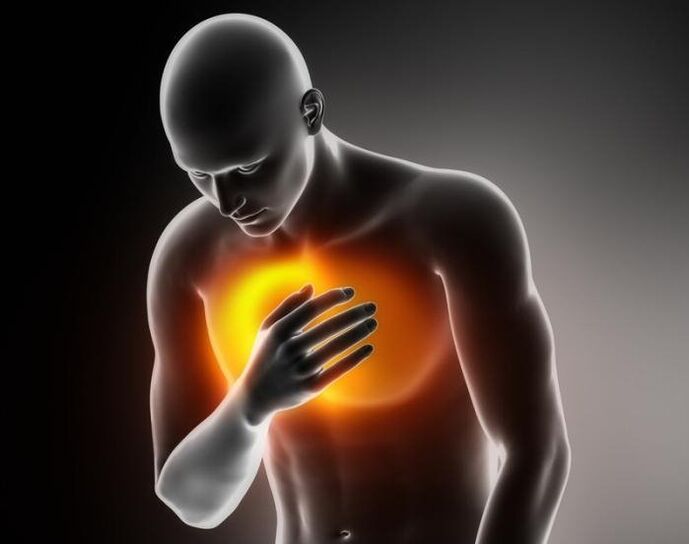
Sometimes thoracic osteochondrosis develops in parallel with the cervical form. So it is very possible to feel a lump in your throat, especially after physical activity.
What are the differences between osteochondrosis and heart pain?
How to distinguish thoracic osteochondrosis from heart diseases, if the symptoms are very similar in many ways? There are a series of signs that you should pay special attention to.
nature of pain
First of all, you should try to analyze the nature of the pain. Many heart diseases also begin with discomfort in the heart area. With osteochondrosis, the pain is compressive.
At the same time, it grows or recedes, but most of the time it does not let go for a long time and is stable. The pulse usually increases, which is even more deceptive. Sometimes there is a feeling of warmth inside the breastbone.
With cervicothoracic osteochondrosis, the patient often complains of pain in the lower cervical vertebrae. Sometimes weakness of the muscles of the left hand is noted, the use of the little finger is especially problematic. Movement of the arms does not relieve, it only aggravates the pain.
Sometimes, the painful sensation extends throughout the left quadrant of the body, affecting not only the chest, but also the neck, left arm, and sometimes the face. This condition can last quite a long time, from a couple of hours to several days.
With incipient angina and heart attack, some pain sensations may be similar in nature. The main difference is that with osteochondrosis, the pain intensifies when inhaling. A tablet of a venodilating agent from the nitrate group or a vasodilator will relieve pain caused by problems in the heart. This method will not help in any way against osteochondrosis.
But when the anesthetic solution is injected into the area of the VI, VII vertebrae of the neck and the I thoracic vertebra, the pain disappears. If distilled water is administered instead of an anesthetic, a slight tingling sensation appears in the chest area. This is a clear sign that the cause of the pain was thoracic osteochondrosis.
Duration of pain
This sign also requires more detailed consideration. If you have heart problems, the pain in your area does not last long, usually a couple of minutes. While the painful sensation caused by thoracic osteochondrosis can last for several days.
But there is also a problem here: if the pain does not go away for several days and there is obvious weakness throughout the body, see a doctor immediately.
It is very possible that the cause of the discomfort was an acute myocardial infarction.
Location of pain
Equally important is the location of the pain. In the case of heart disease, the source of pain is concentrated on the left side of the chest, sometimes the pain radiates to the neck, neck and shoulder. In osteochondrosis, the pain syndrome affects the thoracic, lumbar and cervical spine.
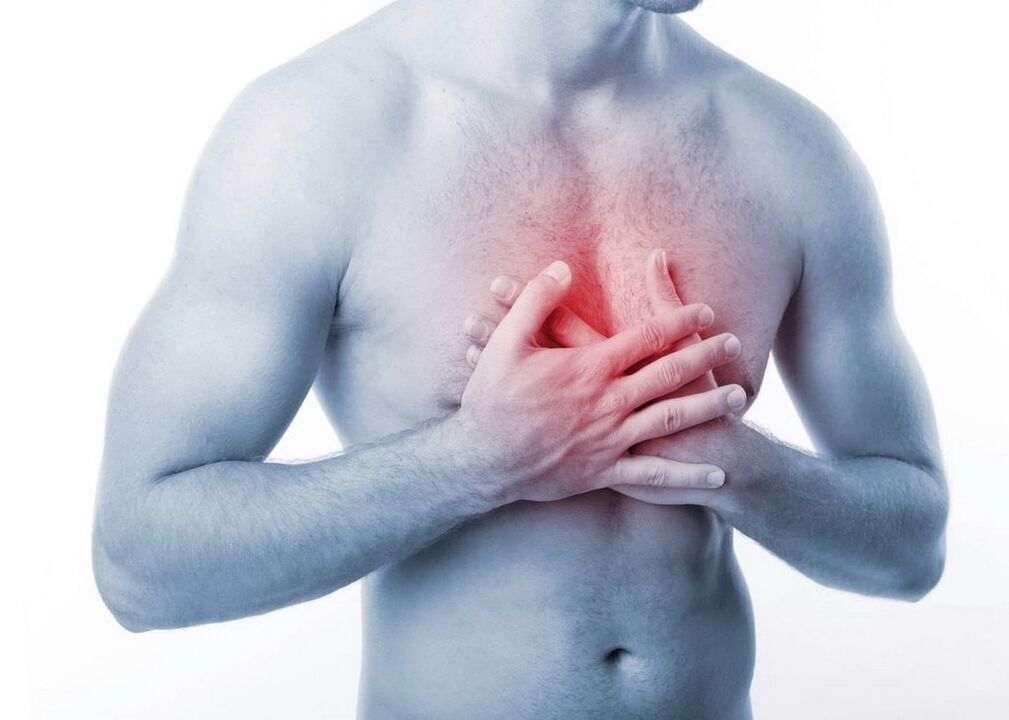
Associated symptoms
Pay attention to the accompanying symptoms. In most cases, heart pain does not go away without an increase in heart rate and breathing. Sometimes the veins in the neck can swell, for example with pericarditis.
With osteochondrosis, this symptom is not observed, but general stiffness in movements may appear.
Why do tachycardia and arrhythmia occur in osteochondrosis?
Arrhythmia is perhaps the most common consequence of neglected thoracic osteochondrosis. With this disease, compression of the artery that runs through the entire spine often occurs.
Compression can occur from both bone growths and hypertonic muscles. As a result, the pressure inside the vessels increases. It requires more effort for the body to "push" blood through the curve. Against the background of this phenomenon, the heart rate increases.
Arrhythmia can manifest itself in different ways. Alternatively, it can cause sinus tachycardia. But how to know exactly what caused tachycardia: heart disease or thoracic osteochondrosis?
- Tachycardia with spinal problems is a constant phenomenon. The number of heartbeats is approximately 90 per minute. It is observed even in a state of absolute rest, while in diseases of the cardiac system, rapid heartbeat occurs with increased physical activity;
- The heartbeat may increase when a person adopts an uncomfortable position, especially if the spine at this moment receives increased stress;
- With osteochondrosis, tachycardia maintains a certain rhythm, the interval between contractions does not change, it is the same all the time;
- As soon as specific treatment of osteochondrosis begins, the tachycardia begins to disappear and the problem self-liquidates.
If a symptom such as tachycardia is not treated and timely treatment is not started, the heart muscle may not be able to cope with the increased load.
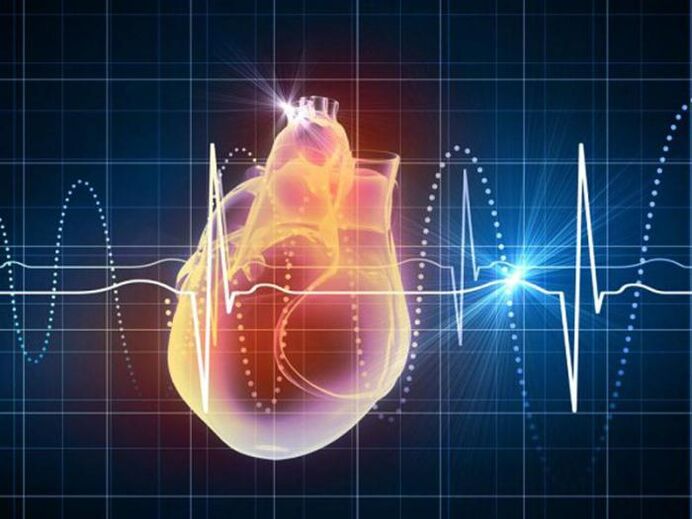
As a consequence of such negligence, extrasystole may develop.
Extrasystole due to thoracic osteochondrosis?
This disease can occur without going through tachycardia. It occurs much less frequently than tachycardia and occurs in advanced forms of osteochondrosis. The disease is also a consequence of an abnormal heart rhythm. It is caused by a premature accelerated contraction of the heart muscle, which immediately follows the normal one.
A person may not feel bad at all. Sometimes you may feel as if your heart has stopped for a moment or, on the contrary, has accelerated. In this case, a very weak pulse is noted. It may not be traceable at all.
If you do not pay timely attention to these symptoms, chronic myocardial hypoxia is likely to develop; This is one of the most serious diseases characterized by insufficient oxygen saturation in the heart muscle. And this is already fraught with more serious problems.
For example, insufficient oxygen supply to the brain, which will also lead to a number of serious disturbances in the functioning of the central nervous system.
The first signs of extrasystole are observed only during physical activity. At rest, the heart rate returns to normal on its own. What signs can be used to determine the presence of extrasystole in osteochondrosis?
- Rapid heartbeat with barely legible pulse;
- The muscles between the shoulder blades are constantly tense;
- A person often feels lightheaded, weak and dizzy;
- Often there is a feeling of increased heat, sweating increases;
- It does not let go of the feeling of internal discomfort;
- The increase in heart rate occurs periodically, is unstable and works on the principle of a wave, sometimes intensifying, sometimes almost disappearing;
- The extrasystolic ejection volume exceeds the norm; this indicator can be determined using a tonometer.
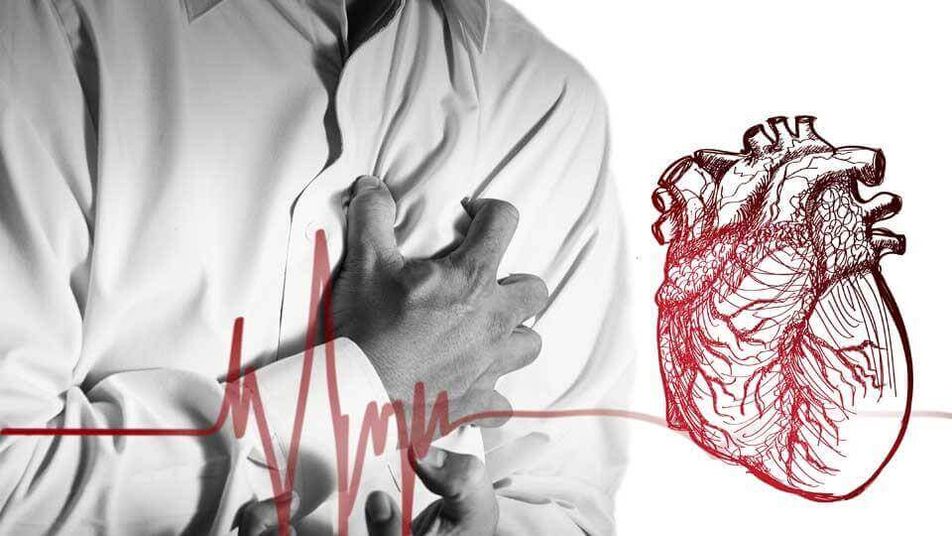
These symptoms can be felt constantly, but most often they intensify at night or at times when the patient is in a horizontal position. Elementary movements of the extremities intensify the symptoms.
This sensation can last for several hours. All attempts to stabilize the heart by taking heart medications do not give a positive result. An attempt to identify the causes of heart disease using an ECG also does not answer the question.
If attempts to administer an anesthetic between the VI and VII vertebrae of the cervical spine and the I vertebra of the thoracic spine gave a positive result, there is no doubt. The cause of heart ailments in this case was precisely thoracic osteochondrosis.
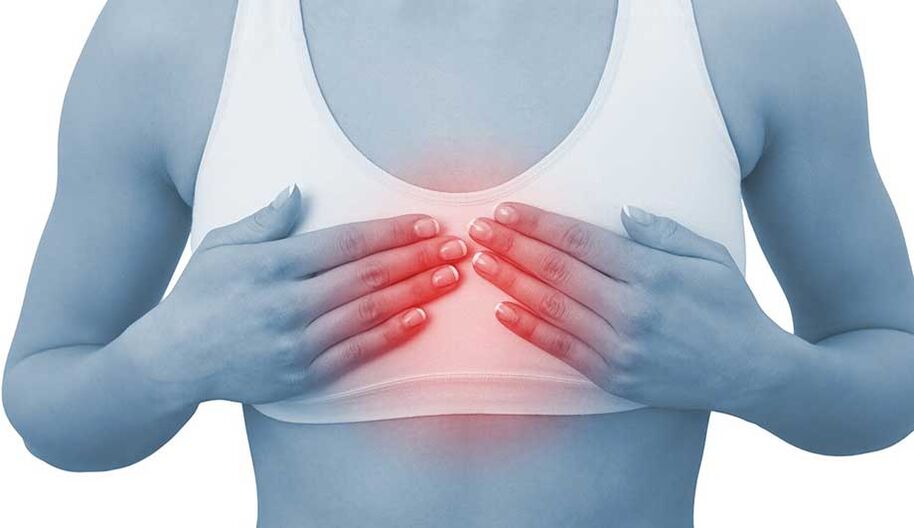
When trying to palpate the thoracic vertebrae, heart pain also increases.
Hypertension as a consequence.
Very often, thoracic osteochondrosis goes hand in hand with high blood pressure. The reason for this duo is compression of the vertebral artery. This can occur due to muscle spasm, resulting in significant inflammation of the muscle tissue. The reason for the compression of the artery can also be the displacement of the vertebrae; This violation also occurs with thoracic osteochondrosis.
For the simple reason that it is the vertebral artery that is responsible for supplying the brain with oxygen and other useful components, there is a lack of substances necessary for normal functioning. Brain cells are in a state of starvation.
To provide the brain with the proper amount of nutrition and "push" blood flow through the curve, the body is forced to increase the speed of blood flow. With this mode of operation, the body automatically begins to release substances that help increase blood pressure.
This allows adequate nutrition to the brain, but leads to hypertension.
If a parallel is not drawn between osteochondrosis and high blood pressure and hypertension begins to be treated as an independent phenomenon, such treatment is unlikely to give a sustainable long-term result. These experiments can only aggravate the situation, adding more problems in the functioning of the cardiovascular system.
How to determine hypertension caused by osteochondrosis?
- Periodically, the patient experiences dizziness, most often during times of overwork;
- Frequent drowsiness, due to insufficient oxygen supply to the brain, the body tries to "store" nutrients to keep vital organs functioning. The sleep state helps save energy;
- Constant weakness is also a result of the brain not receiving enough oxygen;
- Disturbance, confusion;
- The appearance of "floaters" before the eyes - this symptom is often noticed by people with high blood pressure, without knowing that the cause of this pressure probably lies not in the poor condition of the blood vessels, but in osteochondrosis;
- Periodically, all objects begin to look double;
- A deterioration in vision often occurs, the reasons are the same: low oxygen;
- Hearing impairment;
- With a significant lack of oxygen, fainting may occur - this is the body's protective reaction.
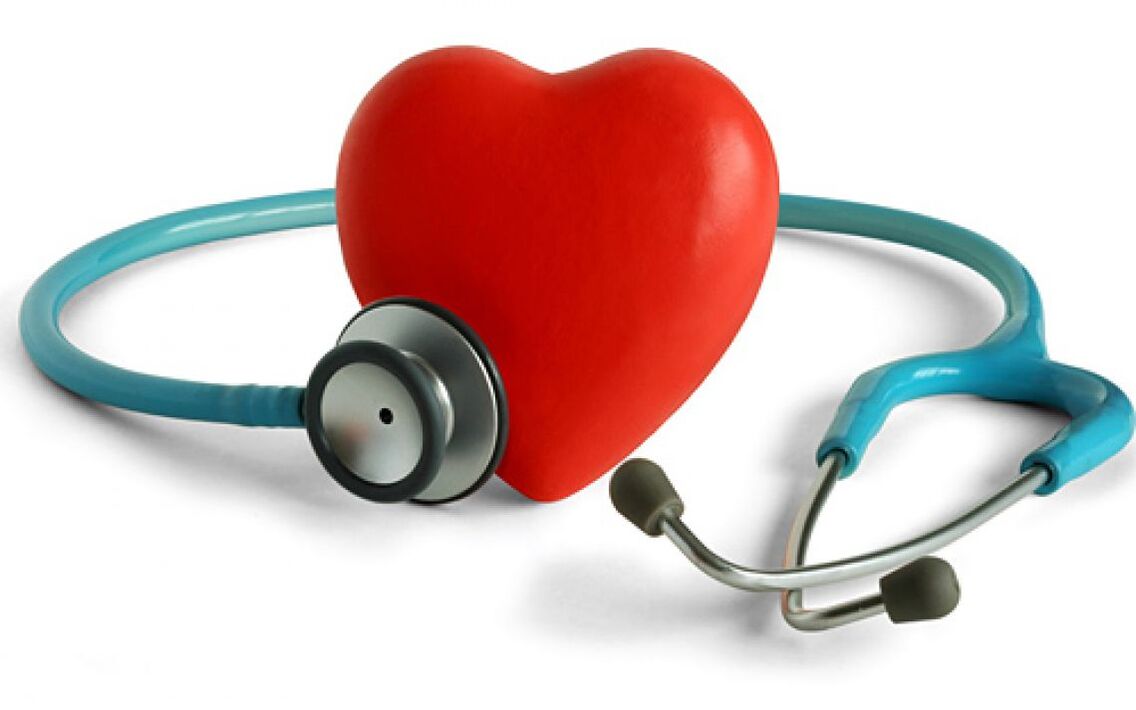
Diagnosis
Knowing the signs of diseases is good, but the most accurate diagnosis can only be made by a doctor using modern diagnostic tools. The simplest and cheapest way is to perform an ECG. This study will allow us to quickly determine if the cause of pain in the heart area is a malfunction of the cardiovascular system or if this condition has another pathology.
If the ECG confirms that the heart is functioning correctly, it makes sense to prescribe an MRI. This method allows you to obtain a layer-by-layer image of the entire column or its parts. These images will allow you to quickly and accurately determine whether a person has problems with the spine.
If suspicions of osteochondrosis are confirmed, treatment should be started immediately.



































